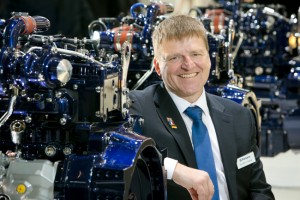Hybrid engine variants unveiled by Perkins
First published at bauma - April 9, 2019
Engine manufacturer Perkins is keeping its customers’ options open when it comes to the next generation of hybrids, showing three hybrid variants on its stand: electric, mechanical and hydraulic.
“We’re showing three flavours of powerplants,” Oliver Lythgoe, of the UK company’s product concept marketing team said. “We know other people are showing hybrids and that some people pick one ‘flavour’, saying ‘This is it’, but we recognise that there’s a huge variety of different sizes of machines and how they operate: their operating cycles, how they use power and how cyclic that usage is.”
The electric version uses a generator or motor to recover energy, for storage in lithium-ion batteries. The advantage of this is that a huge amount of energy can be stored for a long time; the disadvantage is that lithium-ion batteries are expensive, take up a lot of space and release energy only slowly.
Mechanical hybrids, where energy is stored in a flywheel, have the advantage of being relatively small and can release energy suddenly, but that energy degrades over time because the flywheel loses power through friction.
Hydraulic hybrids, which store energy as pressurised hydraulic fluid, are a very mature technology, work best with cyclical forms of operation and can be used to deliver a burst of power.
Lythgoe said there had been three waves of power construction machinery. The first wave, lasting from the 1930s to the early 2000s, usually involved diesels while the ‘Power 2.0’ wave emphasised low emissions. During the ‘Power 3.0’ stage that the industry was now entering, participants were searching for the next step that would further lower emissions and fuel consumption while increasing productivity.
The three prototype engines on show are essentially standard 55kW powerplants that the use of hybrid power systems boosts to 75kW, but Perkins is working on other solutions spanning the power range from 8kW to 600kW.
Some hybrid engines are already in production. Take-up was not by first world nations but by those in more remote parts of the planet, such as telecom industries in countries such as Bangladesh that had poor conventional power infrastructure and which used generators to power their operations.
Stand A4 336
Companies in this article
Perkins
Product Launch Videos
Most popular news
- Fayat’s forward view – at bauma 2019
April 16, 2019 - Hitachi’s ZX65USB-6 mini excavator works harder with less fuel
April 15, 2019 - Komatsu boost fuel efficiency with its WA475-10 wheel loader
April 15, 2019 - Smiley Monroe launches conveyor belt page turner at bauma 2019
April 12, 2019 - Topcon’s sophisticated head-up display goes on show at bauma 2019
April 12, 2019 - Liebherr’s innovative piling rigs at bauma 2019
April 12, 2019












